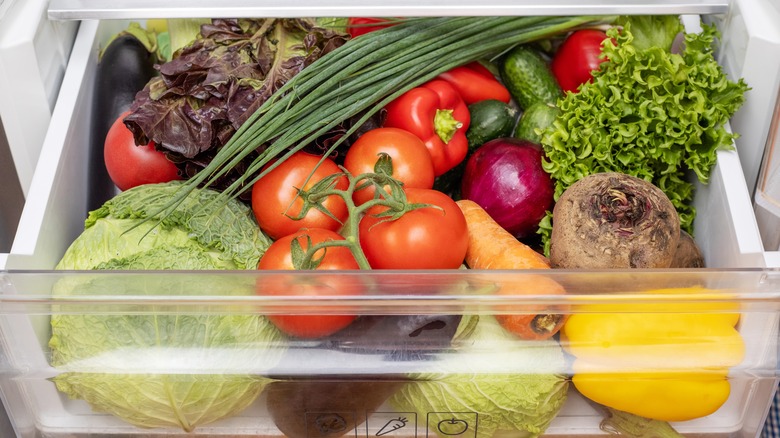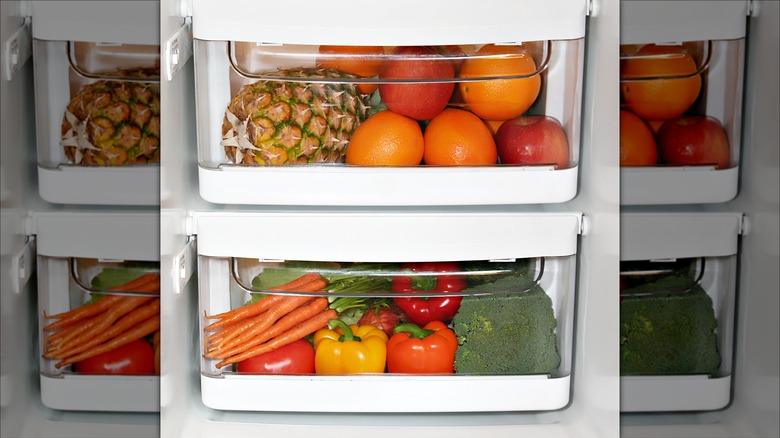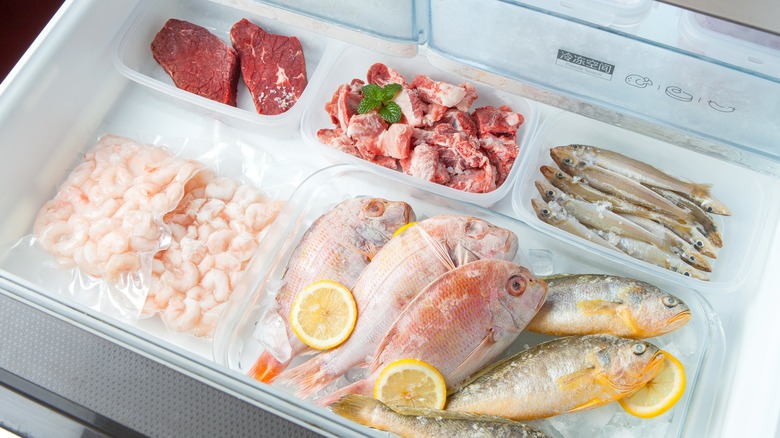Apparently, There's A Correct Way To Store Produce In Fridge Drawers
Does this sound familiar? You return from the supermarket with a bounty of fresh produce and, more or less indiscriminately, pop it all into the bottom cabinets of the fridge for storage? The crisper drawer(s) are designed to control the airflow and humidity inside, which will help certain items to last longer, but not others. When vegetables get chucked in the drawer without a second thought about their humidity needs, the crisper can do more harm than good, and some of the produce could spoil prematurely.
Many crispers have controls that adjust the vents, allowing more or less airflow into the container. The "low" setting completely opens the vents, creating a dryer climate, and the "high" setting closes the vents, making for a danker environment. The key is to separate produce between the two drawers based on humidity needs. You should also consider items that emit our frenemy ethylene. It's the gaseous chemical responsible for making our fruit ripe, but it also contributes to spoilage. Some items — like onions and potatoes – don't store well together in part because of ethylene, and this, along with climate demands, should be accounted for when storing fruit and vegetables in the crisper of the fridge.
Separate based on humidity needs
For fruits prone to rotting, like apples, pears, and stone fruits like apricots, fill the crisper with the vent open. These items all give off high levels of ethylene, and if stored near ethylene-sensitive produce like lettuce and peppers, they can cause these items to decay. The open vent will allow the ethylene to escape the drawer and limit the ripening process. Closing the vent to make a high-humidity bin is best for things prone to wilting or drying out, like leafy greens, broccoli, and fresh herbs – which last even longer if you wrap them in a damp paper towel. These goods are also prone to spoilage due to ethylene exposure, so keeping them closed off from items that emit the gas will keep them perked up when you get around to preparing them.
When a fridge only has one crisper drawer it's best to use it for items that like humidity, as you can put produce that doesn't do well in moist climates in a basket or bowl on the lower shelf. The airflow it receives on the shelf is sufficient to keep your fruit from spoiling too fast. Even if you have two crisper containers, this is an efficient way to store food in the fridge because you can utilize the bottom drawer to safely stash meat.
Store food in the fridge like the professionals do
In commercial kitchens, raw meat is stored on the bottom shelf of a fridge because a leaking package won't cross-contaminate any other food. You can mimic this practice at home by utilizing the bottom crisper drawer to house all your raw protein. Humidity shouldn't affect how long the meat stays good, so it doesn't matter if the container has a vent setting or not.
The crisper drawers should never be overfilled to ensure they are working at peak efficiency. They should only be filled halfway to two-thirds full so everything has room to breathe and nothing freezes or gets damaged by the weight of other produce in the bin. To make a little extra room in the fridge, consider not refrigerating items that don't need to be that cold. Potatoes, onions, and garlic store best in a cool pantry. And tomatoes should only be refrigerated if they are starting to spoil and are best kept between 40 and 60 degrees Fahrenheit.
When working through your stock, take another page from the commercial kitchen book and fill your fridge using the first-in-first-out method, or FIFO. By loading the containers from the back, you keep your oldest product in the front of the drawer, you are less likely to forget about it sitting in the back before it can get used.


